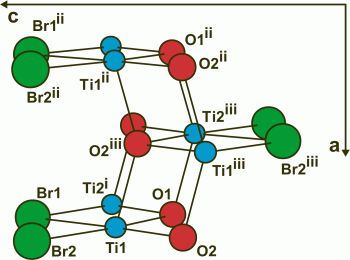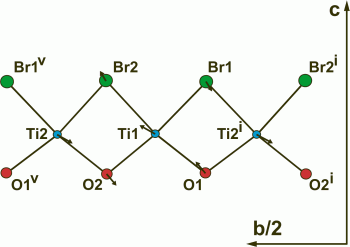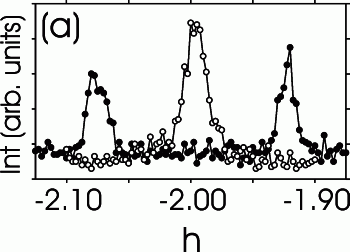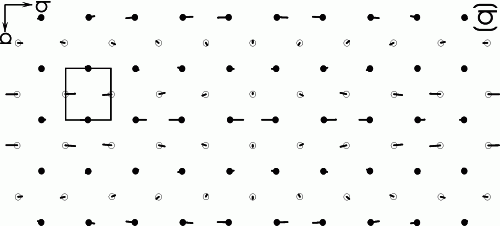Research at the Laboratory of Crystallography
TiOCl and TiOBr are isostructural compounds that exhibit quasi-one-dimensional (1D) magnetic behavior with S = 1/2 magnetic moments on the Ti atoms. Below Tc1 = 67 K (TiOCl) or Tc1 = 27 K (TiOBr) both compounds are in a spin-Peierls state [1]. The spin-Peierls state is characterised by a pairing of the spins of electrons on neighbouring atoms, accompanied by a dimerisation of the crystal lattice. The result is a state with complete magnetic order (zero value for the magnetic susceptibility).
At the Laboratory of Crystallography we have measured temperature dependent X-ray diffraction with synchrotron X-ray radiation at Hasylab in Hamburg. The known room-temperature structure could be confirmed (Fig. 1), but below Tc1 superlattice reflections have been discovered, that indicate a twofold superstructure. Refinements of the superstructures at T = 20 K show both compounds to be isostructural at low temperatures. Atomic displacements (arrows in Fig. 2) have been found to indicate a spin-Peierls state, that is the result of direct exchange interactions between electrons on the chains of Ti atoms parallel the crystallographic b axis [2,3].

Fig. 1: Perspective view of one layer of the crystal structure of TiOBr. Crystallographically independent atoms are indicated by numbers. Different but symmetry equivalent atoms are indicated by superscripts i and ii. The unit cell axes a and c are indicated.

Fig. 2: One ribbon of TiOBr parallel b and c, containing a chain of Ti atoms; The displacements in the superstructure are given by arrows (20 x the true values).
For temperatures between Tc1 = 27 K and Tc2 = 47 K we have discovered incommensurate satellite reflections in the diffraction of TiOBr (Fig. 3). The existence of an incommensurately modulated crystal structure provides an explanation for the first-order character of the phase transition at Tc1. Refinements of the incommensurate crystal structure show that the transition at Tc1 is the result of a competition between the spin-Peierls state (1D interactions) and a state of 2D magnetic order, thus resulting in an incommensurate superstructure [4].

Fig. 3: Q-scans along a* centered on (-2, -3.5, -1). Open circles (data at T=17.5 K) indicate a twofold superstructure. Full circles (data at T = 37 K) show a pair of incommensurate satellite reflections. Lines are a guide for the eye.

Fig. 4: Incommensurately modulated structure of TiOBr at T = 37 K. One double layer of Ti atoms parallel to the a,b-plane is shown for the 2D modulation with orthorhombic symmetry. Atoms are depicted at their basic positions, with shifts towards their true position indicated by arrows with a length of 20 times the true displacements. Dark and light circles represent Ti atoms at -z and z, respectively. 5x11 unit cells of the basic structure are displayed.
Participating researchers at the Laboratory of Crystallography in Bayreuth: Andreas Schönleber, Lukas Palatinus#, Mohammad Shaz and Sander van Smaalen.Part of this research has been done in collaboration with M. Hoinkis, M. Klemm, S. Horn and R. Claessen (Dept. of Physics, University of Augsburg; present address: University of Wurzburg).
Literature and Publications:
[1] A. Seidel, C.A. Marianetti, F.C. Chou, G. Ceder and P.A. Lee: S = 1/2 chains and spin-Peierls transition in TiOCl, Phys. Rev. B 67, 020405(R) (2003).
[2] M. Shaz, S. van Smaalen, L. Palatinus, M. Hoinkis, M. Klemm, S. Horn and R. Claessen: The Spin-Peierls transition in TiOCl, Phys. Rev. B 71, 100405(R) (2005).
[3] L. Palatinus, A. Schönleber and S. van Smaalen: Two-fold superstructure of titanium(III)-oxybromide at T = 17.5 K, Acta Crystallogr. C 61, i48-i49 (2005).
[4] S. van Smaalen, L. Palatinus and A. Schönleber: Incommensurate interactions and non-conventional spin-Peierls transition in TiOBr, Phys. Rev. B 72, 020105(R) (2005).
#Permanent address: Institute of Physics of the Academy of Sciences in Prague, Czech Republic.
